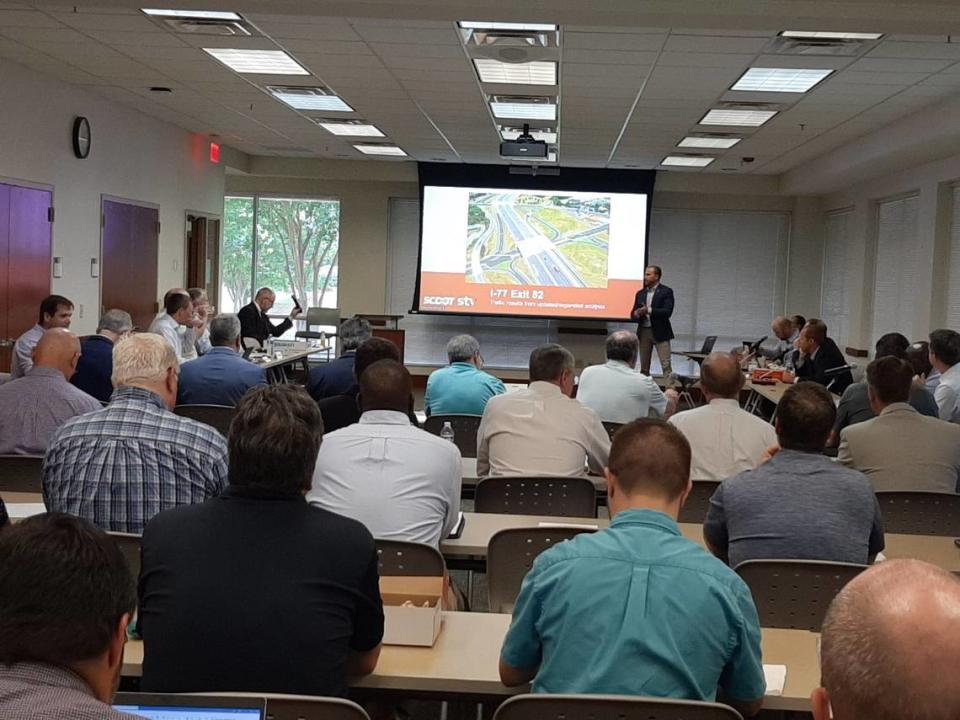A Rock Hill traffic headache could cost $200 million to fix. Here are the options
Upgrades to improve traffic at Interstate 77, Cherry Road and Celanese Road in Rock Hill could cost up to $200 million, according to the South Carolina Department of Transportation.
Yet there’s a higher cost of doing nothing. “It’s not pretty,” said project manager Berry Mattox with the transportation department.
Traffic models show by 2050, almost 8,000 vehicles per day that need to use the Exit 82 interchange won’t be able to get on or off it during afternoon rush hour. Many more vehicles will see significant travel delays.
The Transportation Department is finalizing a report on what to do to avoid that scenario.

What options are SCDOT considering?
Eight options have been studied. Officials are honing in on these three.
▪ A diverging diamond similar to the Gold Hill Road interchange in Fort Mill would cost $90 million to $120 million. Traffic swaps sides of the road between two signals to eliminate left turns. Celanese would get one but Cherry wouldn’t.
Diverging diamonds help getting traffic on and off an interstate, but aren’t as efficient for through traffic on the smaller road.
The sloped concrete under the interstate bridge would be removed to get another turn lane under it, heading north on the interstate. Adding a traffic signal and through traffic volume as the area grows are concerns. Smaller footprint and cost are advantages.
▪ A dual lane on-loop would double right lane turn capacity. Two lanes under the interstate bridge would swing up to join the interstate. Some bridge work would would be needed, but it would require just one traffic signal. Projected costs are $96 million to $125 million.
“It’s simpler,” Mattox said. “It doesn’t require the shifting of lanes. It’s pretty intuitive. We’re just kind of beefing up what’s out there now.” The smaller footprint creates minimal access to businesses. It could impact an access drive, and possibly a cell tower.
▪ A flyover bridge design would be similar to ongoing construction at Exit 85 in Fort Mill, near Kingsley and Baxter on S.C. 160. The cost would be $175 million to $200 million.
“The right-of-way costs on this have got to be astronomical,” said York County Councilman Tom Audette.
A flyover bridge would start as Celanese approaches Cherry, to get onto the northbound interstate. The bridge would have to rise above an already elevated interstate. While the Fort Mill job meant taking strips of property, something similar on Celanese would have a wider impact.
“This you’re talking business relocations,” Mattox said.
Why is the I-77 cost so high?
Rock Hill-Fort Mill Area Transportation Study administrator David Hooper knows the cost seems high.
“But it’s not out of character with what we’re seeing all across the planning area on large projects,” he said.
The Exit 85 work at S.C. 160 costs $140 million. Upgrades at Carowinds Boulevard are up to $90 million. The new Exit 81 interchange in Rock Hill, built for the Carolina Panthers before that headquarters plan failed, cost $90 million.
Even non-interstates are much higher than they were just a few years ago. Widening along U.S. 521 in Indian Land is projected at $115 million to $140 million.
“This is what we’re having to do to keep up with all the growth and the land use decisions that we’re making,” Hooper said. “It’s coming with a big price tag.”
There aren’t many companies that can handle such large projects, Hooper said.
Planners also don’t want to overlap too much work in close proximity. Construction on Exit 82 isn’t expected until Exit 85 is finished or close to it. The other challenge is high-growth areas like York County need more than traditional widening jobs.
Gold Hill opened two years ago as the first diverging diamond in the state. The S.C. 160 job is the first directional interchange. If Celanese gets the dual lane on-loop, it too would be first-in-the-state of its kind.
“The innovative nature of the improvements themselves, that’s part of what’s driving this,” Hooper said.
How will Rock Hill pay for road work?
Cost estimates are based on 2026-27 fiscal year funding. The longer the wait, the higher the cost is likely to be. S.C. GOP. Sen. Michael Johnson, who represents northern parts of York and Lancaster counties, said escalating costs have been an issue not just locally but statewide.
“If you’re going to do something at the $125-million range, it’s really going to cost you $180 (million),” he said.
State officials are looking closest at the diverging diamond and dual lane on-loop options. But each one has trade-offs.
The flyover was the most expensive option in Fort Mill at Exit 85, but demand warranted it and construction on new bridges largely meant crews don’t have to stop traffic to work on existing roads. Cheaper, smaller options could mean more construction delays.
“What’s the impact on the two-, two-and-a-half- year period when you’re building?” Johnson said.
Hooper’s group has about $120 million designated for the Exit 82 project in Rock Hill. Not all of it is available today.
It’s a mix of existing and future federal funding, state infrastructure bank funds and York County money to match state grants.
The state will further refine its choice through the end of the year. The Federal Highway Administration also will have a say in which option is the final pick.

